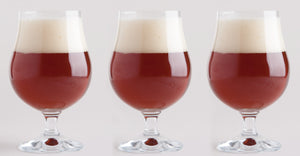Roggenbier
Sometimes inspiration comes when you’re least expecting it. The idea to brew a roggenbier came after taking the BJCP exam on January 7, 2006. One of the questions came completely out of left-field and took everyone by surprise. Describe the characteristics of a Roggenbier and give commercial examples. Huh?! Of course, it was in the study guide, but really…come on guys!!! I’m pretty sure that no one taking that test got the question right.
After that little moment of frustrated disbelief I thought – Ok, I’m going to find out about this damn beer and brew some!
Roggenbier, or German Rye Beer was a popular beer style in medieval northern Germany, where barley did not grow very well. In the middle ages however, Roggenbeir was outlawed, as the Bavarian Beer Purity Law of 1516 forbid brewing with anything other than barley. Rye was a dependable crop though, so it survived as a hearty bread-making grain.
Roggenbier is basically a dunkelweizen that uses rye in place of wheat in the grist. Rye, like wheat, has no husk material and has large amounts of beta-glucans, so lautering can be very slow. Combine this with the traditional German decoction method, and you’ve got a very long, sticky brew day on your hands. (Yes, rice hulls are your friend!)
We started out with about 12 lbs. of grain and mashed into 3.75 gallons of water. (Roughly 1.2 qt/ lb.) Our first rest was the Beta-Glucan rest, at 95ºF. I would highly recommend performing this step whether you’re doing a decoction or step-infusion mash. The next step, after pulling a thick decoction and eventually returning it to the main mash, was a protein rest at 122ºF. We did our saccharafication rest (after pulling another decoction) at 148ºF, and finally mashed out at 168ºF. At this point we added our rice hulls and started to re-circulate. The run-off was VERY slow and actually stuck twice, prompting us to add more Rice Hulls. The mash was very viscous and actually felt oily if you dipped your fingers in the mash and rubbed them together. Our run-off gravity was 1.040. We did not get as much efficiency as we would have liked, but that’s what we get for using 60% rye!
We really wanted to feature the flavor of the rye, so we did not use a flavor-hop addition – only bittering and aroma. And we kept those additions fairly small.
We used two strains of yeast – one hefeweizen strain, and one Bavarian lager strain. The thought behind this was that we would get some of the nice banana-clove aromas from the hefeweizen yeast, while the lager yeast would clean things up a little and keep the ester production from going overboard.
The results were definitely worth the effort. The finished beer was deeply copper and orange in color, with a ridiculously long-lasting tight lace of foam. The flavor was light and refreshing with a subtle spiciness. The mouthfeel was quite creamy and slightly oily, but the spicy quality of the rye helped give it a clean, crisp finish.
It was definitely the longest, hardest brew day I’ve experienced, but also probably the most rewarding. We were very happy with the results. You might be too…Give rye a try! (but do yourself a favor and cut back on the 60% rye…)
Click here to read Jeremy and Steve's Roggen Ruse Rye Recipe!

